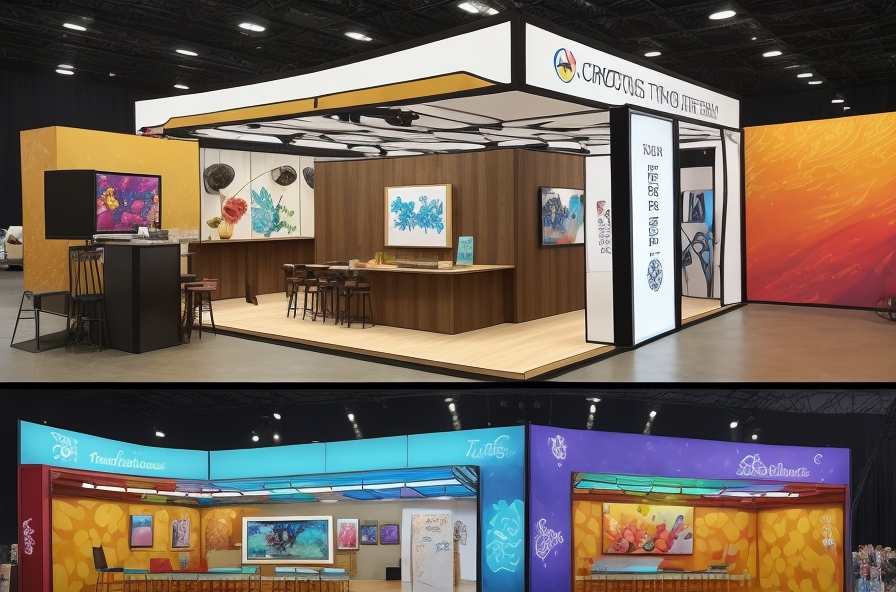Hey there, artists and crafters! Are you gearing up for an upcoming art fair, market, or exhibition? If yes, let’s talk about the one thing that can make or break your event – your art booth. Sure, your artwork might be top-notch, but if your booth doesn’t catch people’s eye, you might go unnoticed.
But fear not! You don’t need to be a design guru to create an eye-popping, wallet-opening booth. In this blog post, we’ll dive into nine innovative and easy-to-implement art booth display ideas that will help you attract more visitors and make more sales.
Table of Contents
The Power of Lighting: Illuminate to Captivate
First off, let’s chat about lighting. Poorly lit booths are like bad first dates—forgettable. A well-lit booth, however, highlights your art in the best possible way, pulling people in like moths to a flame. Consider adjustable LED lights to illuminate specific pieces or create ambiance.
Remember, the right lighting not only showcases your art but also sets the mood. A warm glow can create a welcoming atmosphere, while spotlighting can make your artwork look like they belong in a high-end gallery.
Signage: The Art of Getting Noticed
A good sign can make all the difference. Think of it as your booth’s elevator pitch. It should be eye-catching, easy to read, and, most importantly, convey who you are. You can go minimalist with a sleek black and white sign or let your creativity run wild.
The key is consistency. Make sure your signage complements your art style. If your artwork is modern and edgy, you don’t want a shabby-chic sign throwing people off.
Tabletop Displays: Less is More
Overcrowding your table can be a big no-no. People can feel overwhelmed, which might make them move along without really seeing your art. Aim for a clean, organized display where each piece has breathing space.
Use varying heights to create visual interest. You can use wooden crates, acrylic stands, or even stacks of books to elevate some pieces. This makes your display dynamic and makes it easier for people to engage with your work.
Wall Space: Vertical Real Estate
Why limit yourself to the table? Make use of the walls to show off your art. Hanging your art on the wall not only draws the eye upward but also frees up valuable table space for other things like your portfolio or merchandise.
However, keep it organized. Use uniform frames or hang your art in a grid to make it aesthetically pleasing. You want the focus to be on your art, not on how cluttered your booth looks.
Color Coordination: Set the Mood
The color palette you choose can say a lot about your brand. Bright, vibrant colors may attract a younger crowd, while muted tones may draw in an older or more sophisticated audience. So think about the kind of vibe you want to set.
Color coordination also helps in guiding the visitor’s eye. A cohesive color scheme is more visually pleasing and makes your booth stand out among a sea of disorganized displays.
Interactive Elements: Engage and Connect
An interactive booth is an unforgettable booth. How about a live painting session? Or perhaps an interactive digital screen where visitors can sign up for your newsletter? It’s all about engaging people and making them part of the experience.
In today’s social media age, consider creating a booth that’s Instagram-worthy. An interactive or visually appealing corner can encourage visitors to take photos, which they might share online, giving you free advertising.
Packaging: First Impressions Last
People love buying art, but they love it even more when it’s packaged beautifully. It’s like getting a gift, even if it’s for themselves. Custom tags, unique wrapping paper, or even a simple ribbon can go a long way.
Plus, good packaging not only adds value to your product but also acts as a walking advertisement. Imagine a visitor walking around the event with your beautifully packaged artwork. It’s bound to get people talking and wondering where it came from.
Creating a Portfolio: Show Your Range
A well-curated portfolio on your table allows visitors to see the range and versatility of your work. It helps people connect with your art on a deeper level and can often be the deal sealer.
Make sure your portfolio is easily accessible and maybe even consider having a digital version on a tablet. That way, people can swipe through and see more of what you have to offer.
Conclusion: Ready, Set, Display!
Phew! That was a lot to cover, but hopefully, you’ve got some great ideas and inspiration for setting up your next art booth. Remember, your booth is an extension of your art, so give it the time and attention it deserves. Happy crafting, and may your booth be the talk of the art fair!
Check out the rest of the ‘Updated Ideas‘ site; there are some cool articles waiting for you! Fancy writing for us? Just give that contact button in the top right a tap. Cheers!

